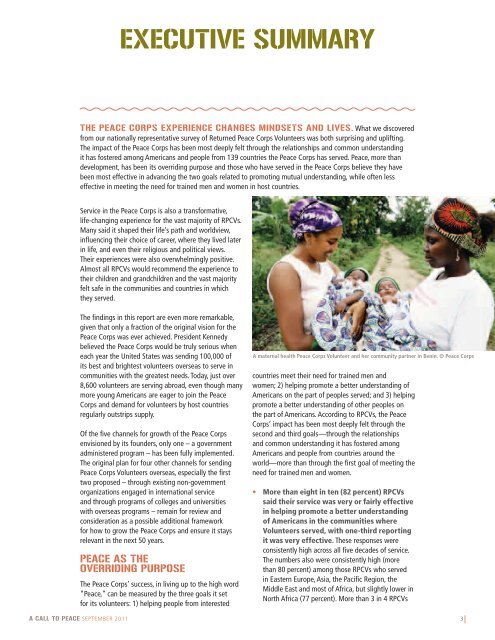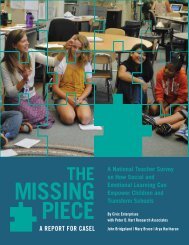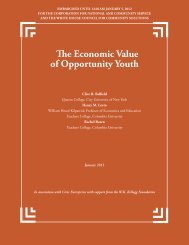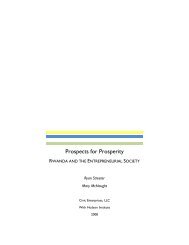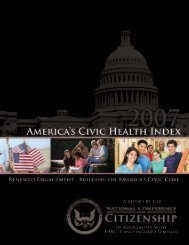A Call to Peace - Civic Enterprises
A Call to Peace - Civic Enterprises
A Call to Peace - Civic Enterprises
- No tags were found...
Create successful ePaper yourself
Turn your PDF publications into a flip-book with our unique Google optimized e-Paper software.
EXECUTIVE SUMMARYTHE PEACE CORPS EXPERIENCE CHANGES MINDSETS AND LIVES. What we discoveredfrom our nationally representative survey of Returned <strong>Peace</strong> Corps Volunteers was both surprising and uplifting.The impact of the <strong>Peace</strong> Corps has been most deeply felt through the relationships and common understandingit has fostered among Americans and people from 139 countries the <strong>Peace</strong> Corps has served. <strong>Peace</strong>, more thandevelopment, has been its overriding purpose and those who have served in the <strong>Peace</strong> Corps believe they havebeen most effective in advancing the two goals related <strong>to</strong> promoting mutual understanding, while often lesseffective in meeting the need for trained men and women in host countries.Service in the <strong>Peace</strong> Corps is also a transformative,life-changing experience for the vast majority of RPCVs.Many said it shaped their life’s path and worldview,influencing their choice of career, where they lived laterin life, and even their religious and political views.Their experiences were also overwhelmingly positive.Almost all RPCVs would recommend the experience <strong>to</strong>their children and grandchildren and the vast majorityfelt safe in the communities and countries in whichthey served.The findings in this report are even more remarkable,given that only a fraction of the original vision for the<strong>Peace</strong> Corps was ever achieved. President Kennedybelieved the <strong>Peace</strong> Corps would be truly serious wheneach year the United States was sending 100,000 ofits best and brightest volunteers overseas <strong>to</strong> serve incommunities with the greatest needs. Today, just over8,600 volunteers are serving abroad, even though manymore young Americans are eager <strong>to</strong> join the <strong>Peace</strong>Corps and demand for volunteers by host countriesregularly outstrips supply.Of the five channels for growth of the <strong>Peace</strong> Corpsenvisioned by its founders, only one – a governmentadministered program – has been fully implemented.The original plan for four other channels for sending<strong>Peace</strong> Corps Volunteers overseas, especially the firsttwo proposed – through existing non-governmen<strong>to</strong>rganizations engaged in international serviceand through programs of colleges and universitieswith overseas programs – remain for review andconsideration as a possible additional frameworkfor how <strong>to</strong> grow the <strong>Peace</strong> Corps and ensure it staysrelevant in the next 50 years.PEACE AS THEOVERRIDING PURPOSEThe <strong>Peace</strong> Corps’ success, in living up <strong>to</strong> the high word“<strong>Peace</strong>,” can be measured by the three goals it setfor its volunteers: 1) helping people from interestedA CALL TO PEACE SEPTEMBER 2011A maternal health <strong>Peace</strong> Corps Volunteer and her community partner in Benin. © <strong>Peace</strong> Corpscountries meet their need for trained men andwomen; 2) helping promote a better understanding ofAmericans on the part of peoples served; and 3) helpingpromote a better understanding of other peoples onthe part of Americans. According <strong>to</strong> RPCVs, the <strong>Peace</strong>Corps’ impact has been most deeply felt through thesecond and third goals—through the relationshipsand common understanding it has fostered amongAmericans and people from countries around theworld—more than through the first goal of meeting theneed for trained men and women. More than eight in ten (82 percent) RPCVssaid their service was very or fairly effectivein helping promote a better understandingof Americans in the communities whereVolunteers served, with one-third reportingit was very effective. These responses wereconsistently high across all five decades of service.The numbers also were consistently high (morethan 80 percent) among those RPCVs who servedin Eastern Europe, Asia, the Pacific Region, theMiddle East and most of Africa, but slightly lower inNorth Africa (77 percent). More than 3 in 4 RPCVs3|


